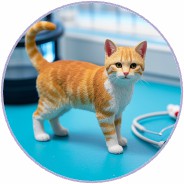- Home
- Solutions
- By Services
- Ophthalmic Disease Model Development Services
- Animal Model Development Services
- Genetically Engineered Model Development Services

Developing engineered animal models is a complex and lengthy undertaking in the pharmaceutical sector. At Protheragen, we focus on the creation of ophthalmic disease-specific genetically engineered animal models for disease diagnostics and therapeutics development.
Genetically altered animals serve as advanced and practical models for biomedicine research, allowing scientists to transform biomedical technology completely. These models entail specific alterations in an animal's genetics so that the impact of certain genetic changes on health and disease can be studied. Animals with genetic modifications are very helpful for studying the processes of various human diseases and possible ways to combat them. These models are particularly important in the study of multi-factorial diseases which involve the action of several genes and environmental factors.
Table 1. Important animal models used in biomedical research. (Singh V. K., et al., 2021)
| Animal Models | Disadvantages | Advantages |
| Rodent-Mice | Sequential blood samples from the same animal are difficult | Small, easy to handle, inexpensive, several genetically well-defined strains, availability of humanized and recombinant technology-modified animals, a wide range of reagent availability |
| Rodent-Rats | Availability of fewer genetic tools and reagents compared to mice | Similar to mice but comparatively larger in size |
| Rabbits | Fewer genetic tools, fragile bones, lack of reagents | Easy to handle, nonaggressive, economical compared to other large animals, widely bred, and easy availability |
| Hamster | Fewer genetic tools and reagent availability | Easy to handle, nonaggressive, economical |
| Minipig | Expensive to maintain, need for vascular access port due to deep veins, lack of reagents | Inbred, large, similar with humans in several respects, suitable for cutaneous work |
| Canine-Dogs | Used as a pet, involves ethical and societal issues, expensive | Well-defined in several areas of research, large, outbred |
| Pig | Similar limitations as minipig | Similar to minipig, larger in size, outbred |
| Sheep | Expensive, limited reagent availability | Suitable for antibody work |
| Horse | Expensive to procure and maintain, large size creates limitations for radiological imaging work | Provides the benefits of a large animal model |
| Goat | Expensive, limited reagent availability | Easy to handle, suitable for antibody work |
| NHP-Rhesus | Involves ethical issues, expensive, limited supply | Large, similar to humans, significant DNA homology with humans, well-defined model, complex pedigrees |
| NHP-Baboon | Similar to rhesus, difficult to procure, limited availability | Similar to rhesus, suitable for studies of osteoporosis, alcohol metabolism, and lipoproteins |
| NHP-Cynomolgus | Similar limitations as rhesus | Similar to rhesus |
| Zebrafish | Remote from humans compared to other animal models, physiology not identical to humans | High degree of homology with the human genome, a large number of experiments can be performed in a short time period |
As most ocular diseases are hereditary, using animal models in ophthalmology has facilitated genetic research for a wide array of identified eye diseases which include cataracts, glaucoma, retinitis pigmentosa, and Leber's congenital amaurosis. In particular, having animal models who have human genetic mutations allows scientists to observe and test disease development along with therapy interventions and replacement ideas. For example, Pde6b gene mutation models for retinitis pigmentosa and Rpe65 knockout models for Leber congenital amaurosis provide insight into the complex disease processes. Understanding such ophthalmic diseases will help further improve therapeutic approaches.
 Fig.1 Relative comparison of eyeball size and morphology among different species in eye studies. (Loiseau A., et al., 2023)
Fig.1 Relative comparison of eyeball size and morphology among different species in eye studies. (Loiseau A., et al., 2023)Our comprehensive services encompass the design, creation, and validation of models that accurately mimic human eye diseases. We leverage cutting-edge technologies, including CRISPR-Cas9, to introduce precise genetic modifications, ensuring that our models provide reliable and relevant data for your research needs.

Mouse Models

Rabbit Models

Zebrafish Models
LOXHD1 mutants for hearing and vision impairment studies.

Feline Models
Cats with COL8A2 mutations for FECD-like phenotypes.

Porcine Models
α-1,3-galactosyltransferase knockout pigs to reduce graft rejection.

Customized Models
Developing custom animal models based on your specific needs.
Protheragen's team of experts works closely with clients to understand their specific requirements and deliver customized solutions that accelerate the discovery and development of new therapies for ophthalmic diseases. If you are interested in our services, please feel free to contact us.
References
All of our services and products are intended for preclinical research use only and cannot be used to diagnose, treat or manage patients.